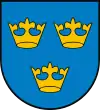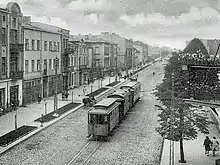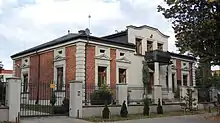Pabianice
Pabianice [pabʲaˈɲit͡sɛ] is a town in central Poland with 64,757 inhabitants (2019).[1] Situated in the Łódź Voivodeship, it is the capital of Pabianice County. It lies about 10 kilometres (6 miles) southwest of Łódź and belongs to the metropolitan area of that city. It is the third largest city in the Łódź Voivodeship by population. The area of the city covers 32.9 square kilometres (12.7 sq mi) being the 10th largest in Łódź Voivodeship.
Pabianice | |
|---|---|
 Zamkowa Street | |
 Flag  Coat of arms | |
 Pabianice  Pabianice | |
| Coordinates: 51°39′N 19°23′E | |
| Country | |
| Voivodeship | |
| County | Pabianice County |
| Gmina | Pabianice (urban gmina) |
| Established | before 10th century |
| Town rights | 1297 |
| Government | |
| • Mayor | Grzegorz Mackiewicz |
| Area | |
| • Total | 32.99 km2 (12.74 sq mi) |
| Highest elevation | 203 m (666 ft) |
| Lowest elevation | 174 m (571 ft) |
| Population (31 December 2019) | |
| • Total | 64,757 |
| Time zone | UTC+1 (CET) |
| • Summer (DST) | UTC+2 (CEST) |
| Postal code | 95–200 |
| Area code(s) | +48 42 |
| Car plates | EPA |
| Primary airport | Łódź Władysław Reymont Airport |
| Website | http://www.um.pabianice.pl |
According to data from 2009[2] Pabianice covers 32.99 km2 (13 sq mi) with following split: agricultural land: 53%, forests: 9%. The city covers 6.70% of Pabianice County.
Neighbour administrative divisions: gmina Dobroń, gmina Ksawerów, miasto Łódź, gmina Pabianice, gmina Rzgów.
Transportation

Pabianice has seen major infrastructural changes over the past few years amidst increased investment and economic growth. The city has a much improved infrastructure with new roads. Pabianice now has a good circular road system. Pabianice bypass (express road S14) opened in May 2012. However, parts of S8 (part of the European route E67) are currently under construction and to be completed within 2012.
Near Pabianice there is an international airport: Łódź Władysław Reymont Airport (IATA: LCJ, ICAO: EPLL) located just 11 kilometres (7 miles) from the city centre.
Public transport in Pabianice includes buses, trams (streetcars), as of 2013 commuter railway Łódzka Kolej Aglomeracyjna [3] and regional rail PKP Przewozy Regionalne. The regional rail and light rail is operated by Polish State Railways (PKP). There are also some suburban bus lines run by private operators. Bus service covers the entire city. Currently, the Miejskie Przedsiębiorstwo Komunikacyjne (City Transport Company) company runs line number 41 which connects Pabianice with Łódź City.
History

Pabianice was established in the 10th or 11th century, and was part of early Piast-ruled Poland. In 1297, Władysław I Łokietek granted town rights. Pabianice was a private church town, administratively located in the Sieradz Voivodeship in the Greater Poland Province of the Polish Crown. In 1555, Polish King Sigismund II Augustus issued a privilege, which established craft guilds in Pabianice.[4]


Before World War II, Pabianice had a substantial Jewish population, comprising about a quarter of all residents of the town. Jews had been living in the town since the 1700s. Following the joint German-Soviet invasion of Poland, which started World War II in September 1939, the town was under German occupation. As part of the Intelligenzaktion, in late 1939, the Germans carried out mass arrests of local Polish intelligentsia, who were initially imprisoned in a local transit camp, and then either deported to Nazi concentration camps or mostly murdered in nearby forests.[5] Local Polish teachers and activists were murdered by the Germans during large massacres in the nearby Łagiewniki forest in November and December 1939.[6] The Germans also expelled around 1,000 Poles from the town in December 1939.[7] Under German occupation nearly the entire Jewish population was murdered. Some were murdered in the town, several thousand were sent to the Chełmno extermination camp where they were immediately gassed, and others were expelled to Łódź and to forced labour camps in the area. Only about 150 survived of the 9,000 Jews thought to be living in Pabianice at the start of the war. For more on the wartime experience see Megargee.[8]
Demography
Recently, the population of Pabianice has been steadily decreasing. Between 2002 and 2016 it fell from 72,444 to 66,265 (a decrease of about 400 people every year).[9]

Unemployment
According to source data from 2009[10] average income per capita was on the level of 1844,96 PLN. According to source data from October 2011[11] average unemployment rate in Pabianice is on the level of 15,6%

Architecture
.JPG.webp)

- Church of St. Matthew the Evangelist
- Renaissance fortified manor house of Cracovian Chapter
- Weaver houses (Domy tkaczy)
- "Krusche-Ender" cotton factory buildings
- Old offices "Krusche-Ender" with "prządki" sculpture
- Old palace of Enders' family
- Lutheran Church of St. Peter and St. Paul
- Neo-Gothic Church of Saint Mary
- Railway station
- Renaissance Revival pentecostal chapel near Ludwik Waryński St. (ruins)
- Maria Konopnicka Special Education School Complex
- Pabianicki Harvard Heureka Private Schools
- Christian cemeteries
- Jewish cemetery
- Synagogue (destroyed)
Quarters and administrative subdivisions
Centrum, Bugaj, Piaski, Stare Miasto, Karniszewice, Klimkowizna, Jutrzkowice, Wola Zaradzyńska Nowa, J. Salwy, Marii Konopnickiej, Jana Pawła II, Mikołaja Kopernika, Dąbrowa, Rypułtowice, Czyryczyn (formerly Sereczyn), Karolew, Zatorze.
Sport
| Club | Sport | Founded | League | Venue | Head Coach |
|---|---|---|---|---|---|
| Language School Pabianice[12] | Basketball | 1946 | First League | MOSiR, ul. Grota-Roweckiego 3, Pabianice | Sylwia Wlaźlak |
| Włókniarz Pabianice | Football | 1946 | Łódzka Klasa Okręgowa | MOSiR, ul. Grota-Roweckiego 3, Pabianice | Jacek Włodarczewski |
| PTC Pabianice | Football | 1906 | Łódzka Klasa Okręgowa | Stadium, ul. Stefanii Sempołowskiej 6, Pabianice | Jan Rykała |
Notable people

- Menachem Mendel Alter (1877–1942), Grand Rabbi of Pabianice, son of Rabbi Yehudah Aryeh Leib Alter and brother of Rabbi Avraham Mordechai Alter, murdered in Treblinka August 12, 1942.
- Paweł Janas (born 1953), football player and coach
- Mieczysław Klimek (1913–1995), Polish professor, engineer, prisoner of Nazi concentration camps during World War II
- Marcin Komorowski (born 1984), football player
- Krystyna Mikołajewska (born 1939), actress
- Bolesław Nawrocki (1877–1946), Polish painter
- Józef Pluskowski (1896–1950), poet
- Aleksandra Shelton (born 1982), sabre fencer
- Stanisław Staszewski (1925–1973), Polish architect and poet, Polish resistance participant during World War II, prisoner of the Mauthausen concentration camp
- Jadwiga Wajs (1912–1990), discus thrower
International relations
References
- "Local Data Bank". Statistics Poland. Retrieved 4 July 2020. Data for territorial unit 1008021.
- "Powierzchnia i ludność w przekroju terytorialnym w 2010 r". www.stat.gov.pl (in Polish). Główny Urząd Statystyczny. Archived from the original on 2013-12-20. Retrieved 2010-08-20.
- pl:Łódzka Kolej Aglomeracyjna
- Słownik geograficzny Królestwa Polskiego i innych krajów słowiańskich, Tom VII (in Polish). Warszawa. 1886. p. 805.
- Wardzyńska, Maria (2009). Był rok 1939. Operacja niemieckiej policji bezpieczeństwa w Polsce. Intelligenzaktion (in Polish). Warszawa: IPN. p. 203.
- Wardzyńska (2009), p. 204
- Wardzyńska, Maria (2017). Wysiedlenia ludności polskiej z okupowanych ziem polskich włączonych do III Rzeszy w latach 1939-1945 (in Polish). Warszawa: IPN. p. 180. ISBN 978-83-8098-174-4.
- Megargee, Geoffrey (2012). Encyclopedia of Camps and Ghettos. Bloomington, Indiana: University of Indiana Press. p. Volume II, 88-89. ISBN 978-0-253-35599-7.
- Central Statistical Office (Poland): Demographics Database. (data for 2012-present)
- "Główny Urząd Statystyczny". www.stat.gov.pl (in Polish). Retrieved 2011-12-20.
- "Wojewódzki Urząd Pracy". wup.lodz.pl (in Polish). Retrieved 2012-01-04.
- "PTK Pabianice". www.ptk.pabianice.com.pl (in Polish). Retrieved 5 November 2008.
- "Miasta partnerskie Pabianic". um.pabianice.pl (in Polish). Biuro Promocji Miasta. 4 May 2005. Archived from the original on 26 April 2012. Retrieved 29 August 2008.
| Wikimedia Commons has media related to Pabianice. |


